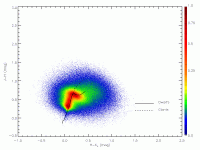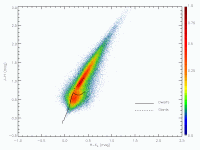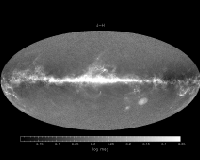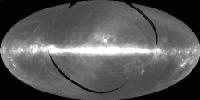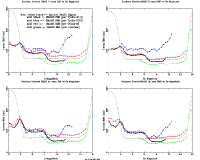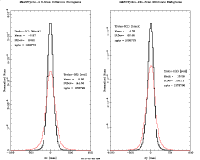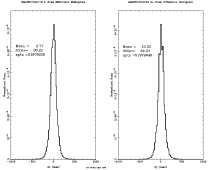c. PSC Source Selection Criteria:
The All-Sky Release PSC contains accurate astrometry and photometry for 470,992,970 near-infrared sources extracted from scans of 59,731 Tiles covering 99.998% of the sky.
Sources in the PSC were drawn from a Working Database of all detections in these Tiles, using the selection criteria described in Section V.3 and summarized in Table 1. The point source Working Database contains approximately a factor of two more detections than are in the PSC; a significant fraction of these are detections of noise and image artifacts. The source detection thresholds in 2MASS pipeline data processing are set intentionally low to insure completeness. The demanding reliability requirements for the 2MASS PSC were achieved by applying the selection criteria listed below.
Users are recommended to review the Cautionary Notes for the PSC in Section I.6.b for known features of and problems in the catalog.
Table 1 - Point Source Selection Criteria for the All Sky Release
| Category | Criteria | Purpose |
|---|---|---|
| Signal-to-Noise Ratio (SNR) and Band-detection | Source must be detected in at least one band with a
SNR>7 OR Source must be detected in three bands with a SNR>5 The SNR thresholds can be satisfied by either the SNR derived from the photometric measurement uncertainty or the scan SNR ([jhk]_snr). | To filter out low SNR noise detections |
| Frame-detection | In at least one detected band, the source position must not
be masked out because of noisy pixels or other transient events
on more than two out of the six (and sometimes seven) frames
sampling its position, AND SNR>20 sources must be detected at SNR>3 on at least 40% of individual the unmasked frames OR The source must have non-saturated detections in all three bands AND it must have been measurable on two frames AND detected with SNR>3 on both of those frames. Frame detection statistics are tabulated for each PSC source in the ndet column. |
Hot pixel, cosmic ray, meteor trail and low reliability source rejection |
| Artifacts | Source must not be identified as a spurious detection of an
image artifact from a bright star. Sources believed to be real, but affected by artifacts, are included in the Catalog, and are flagged using the cc_flg. |
Spurious source rejection |
| Tile Boundaries | Source lies >10´´ from edge of Survey Tile | To avoid <3-band coverage areas at edges of focal plane and other edge effects |
| Multiply-Detected Sources | For multiply-detected sources in Tile overlap regions, only the single apparition farthest from a Tile edge is selected. Sources in the overlap regions not multiply-detected are always included in the PSC, but are properly flagged so that a user can remove the selection bias resulting from multiple opportunities to appear in the catalog. (see V.4) | To eliminate duplicate detections and to avoid sensitivity enhancements in the Tile overlaps through flagging. |
The PSC is a Composite Catalog
The PSC generated with the selection criteria above is a composite release that has two distinct components contained in a single database. The first component consists of a higher SNR, high reliability Catalog that meets or surpasses all of the 2MASS Level 1 Requirements in unconfused regions of the sky. Very bright stars that saturate the shortest 2MASS exposures are included in this set even though they do not satisfy the photometric accuracy requirements of the Survey. The second component of the PSC is a lower signal to noise extension that primarily contains sources that reach 0.5-1.0 mag fainter J<15.8, H<15.1 and Ks<14.3 mag levels, where the PSC is >99% complete. The completeness, reliability and uniformity of the extension sources are not as good as the high-reliability Catalog subset of the PSC, and may not satisfy all of the specifications described in the Level 1 Requirements. They are included in the PSC because, when used with some care, they can be a valuable resource for certain classes of investigations in which homogeneous, statistical datasets are not necessary.
The criteria for selecting the high-reliability Catalog sources in the full PSC are listed in Table 2. The criteria are meant to be applied band-by-band, so technically PSC sources that satisfy the Catalog requirements in one band may not satisfy them all bands. These criteria are discussed in detail in I.6.b.
|
PSC Catalog Subset Criterion (applied band-by-band) |
ph_qual="A" OR (rd_flg="1" OR rd_flg="3") AND use_src="1" |
|---|
d. General Properties of the PSC:
- Number of Objects: Full PSC: 470,992,970 Catalog: 341,317,908
- Number of Detections in Each Band:
Table 3 Band Full PSC High SNR Catalog J 455,371,014 321,117,915 H 436,797,138 269,533,860 Ks 375,248,502 210,729,664 - Band-Detection Combinations (Full PSC):
Table 4 Band-Combination Number Percentage of Total JHKs 359,919,450 76.4 JH 64,724,153 13.7 HKs 7,603,506 1.6 JKs 4,257,125 0.9 J 26,470,286 5.6 H 4,550,029 1.0 Ks 3,468,421 0.7 - Sky Coverage
- Distribution of PSC Sources With Galactic Latitude
Figure 1 shows a 3-color map of average PSC source counts in 5´ × 5´ bins in a galactic aitoff projection, where J-band counts are mapped into blue, H-band into green and Ks-band into red. The density enhancement towards the Galactic Plane and in the bulge of the Milky Way is apparent. Note also the enhancements associated with the Large and Small Magellanic Clouds, and the extinction filaments running through and near the Galactic Plane. In Figure 2 is shown the differential distribution of PSC source counts as a function of galactic latitude. Counts for the full PSC and for the Catalog subset are shown in black and red, respectively. The PSC cumulative source counts as a function of galactic latitude are shown in Figure 3, and summarized in Table 5. 90% of all PSC sources fall within the half of the sky with |b|<30°.
Table 5 - Cumulative Source Counts Full PSC High SNR Catalog |b| < Number Percentage of Total Number Percentage of Total 2° 64,860,852 0.138 52,127,949 0.152 5° 171,536,055 0.364 134,110,427 0.392 10° 285,981,079 0.607 214,860,387 0.628 15° 347,566,169 0.738 256,977,785 0.751 20° 382,750,070 0.813 281,232,441 0.822 30° 421,458,546 0.895 308,171,925 0.900 40° 442,833,953 0.940 323,026,991 0.944 50° 455,114,841 0.966 331,516,768 0.969 60° 462,673,352 0.982 336,675,553 0.984 70° 467,397,538 0.992 339,852,389 0.993 80° 470,076,205 0.999 341,633,227 0.998 90° 470,992,970 1.000 342,237,326 1.000
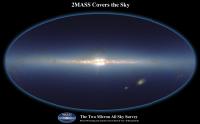
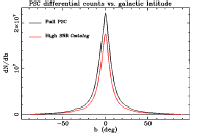
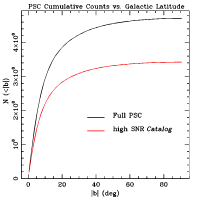
Figure 1 Figure 2 Figure 3 - Differential Source Counts and Detection Limits
The 2MASS PSC is complete down to J<15.8, H<15.1 and Ks<14.3 mag, in the absence of confusion. Sources 0.5-1.0 mag fainter than these limits are included in the PSC, but with decreasing completeness. The source detection limit rises with increasing confusion level.
The J, H and Ks differential PSC source counts, normalized by area, are shown in Figures 4 and 5 for a 702.8 deg2 area with b>+75° and the 10°x10° area centered on l=55°,b=0°, respectively. In each figure, the blue line represents the J-band source density, the green line is H and the red line is Ks. Figure 4 shows that the high latitude PSC contains detections 0.5-1.0 magnitudes fainter than the nominal completeness limits. The turnover in the source counts in the Galactic plane field, shown in Figure 5, illustrates that the completeness limit of the PSC in high source density regions can be nearly 1 magnitude brighter than the north Galactic cap field because of confusion noise. The dependence of completeness with source density is illustrated in Figure 6 which shows an all-sky Galactic aitoff projection map of the Ks magnitude at which the differential source counts peak. The turnover in the source count curves is not a formal measure of completeness, but serves as a proxy to show the variation of the completeness across the sky. A detailed discussion of the variation of PSC source densities and counts is given in VI.7.
The nominal sky coverage of the PSC is 99.997%, slightly less than the 99.998% of the sky covered by the scans of the Survey Tiles. The additional lost area lost is caused by the Tile Edge Boundaries used for PSC source selection (V.3). There are 43 gaps in the PSC coverage encompassing a total of 1.15 deg2. Their locations are given in III.2.c.
Much larger than the area lost due to coverage gaps in the PSC
is the area effectively masked by the scattered light halos, diffraction
spikes and
latent images around very bright stars. The sky coverage of the PSC
lost in the glare of bright stars is 106.2, 156.2 and 177.9
deg2 in J, H and Ks, respectively.
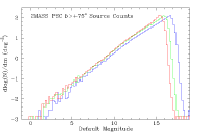
| 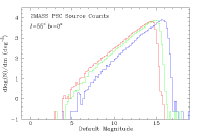
| 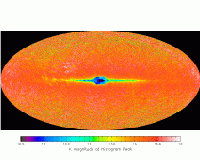
|
| Figure 4 | Figure 5 | Figure 6 |
e. Photometric Properties:
Photometry of bright, non-saturated sources in the 2MASS PSC has a precision of 1-2%. The photometric signal-to-noise ratio is >10 for J<15.8, H<15.1 and Ks<14.3 mag in the unconfused sky. Brightness estimates for stars that saturate the shortest 2MASS exposures are accurate to ~20%.
Photometry of point sources in 2MASS was done using different algorithms depending on how bright a source was relative to the saturation regimes of the Survey observations. The origin of the default magnitudes given for each source is specified by the rd_flg value. Sources that were not saturated on the 1.3 s "Read_2-Read_1" exposures, the vast majority of objects detected in the Survey, were measured using profile fit photometry. These have rd_flg="2" in the appropriate band. Sources that saturated the 1.3 s exposures, but not the 51 ms "Read_1" exposures where measured using aperture photometry on the short exposure frames, and are designated with rd_flg="1" in the appropriate bands. Sources that saturated even the 51 ms exposures have brightness estimates derived from 1-d radial profile fits of the non-saturated portions of their images on the 51 ms exposures. These sources have rd_flg="3" in the appropriate bands.
- Photometric Accuracy
Figure 7 shows the average quoted J, H and Ks default magnitude measurement uncertainties in 0.2 mag bins plotted as a function of source magnitude for all PSC sources having b>+75°. The vertical error bars show the RMS dispersion in the mean uncertainties in each brightness bin and the dashed horizontal lines in each panel show the SNR=10 levels (<
 >=0.109 mag).
The J-band panel is labeled with
the rd_flg values in the appropriate brightness regimes.
>=0.109 mag).
The J-band panel is labeled with
the rd_flg values in the appropriate brightness regimes.
The measurement precision for bright, non-saturated sources (rd_flg="1" or "2") approaches a constant limit of 0.01-0.02 mags that is set by pixelization effects. The characteristic uncertainties increase towards fainter flux levels as background photon noise becomes important. The achieved SNR=10 levels in the north galactic pole field are on average fainter than the J=15.8, H=15.1 and Ks=14.3 mag specified in the Level 1 Requirements. The brightness estimates of the fully saturated sources (rd_flg="3") are of much poorer accuracy than non-saturated sources.
Although the default magnitudes for most non-saturated (rd_flg="2") PSC sources are derived from profile-fit photometry, aperture photometry magnitudes are also supplied. For isolated sources, aperture photometry yields better precision than profile-fit photometry in the high signal-to-noise regime because errors in the point source profile templates dominate the uncertainties in those cases. At lower signal-to-noise ratios (fainter sources), where photon noise dominates the measurement statistics, profile-fitting yields better accuracy. This is illustrated in in Figures 8, 9 and 10, which show the average quoted J, H and Ks photometric uncertainties, respectively, for the profile-fit and aperture photometry of all non-saturated (rd_flg="2") PSC sources with b>+75°. The cross-over points where profile-fit and aperture photomety produce similar uncertainties on average occur at J~14, H~13 and Ks~12.5 mag for this region of the sky.
The point source photometric sensitivity achieved by 2MASS varied with sky conditions, including atmospheric transparency, seeing, and emissive backgrounds, and with the level of confusion noise (VI.2). Quality assurance standards ensured that only data taken under conditions known to meet the sensitivity requirements for the survey were accepted. Figure 11 shows the spatial distribution of the average Ks magnitudes at which the mean measurement uncertainty is ~0.109 mag (SNR=10) in a galactic aitoff projection. Away from the Galactic Center, the SNR=10 level is usually fainter than the minimum of Ks=14.3 mag required for the Survey. The impact of confusion on the extracted photometry is seen by the degraded SNR=10 levels in and around the Galactic Center.
- Band-Band Photometric Performance
The J-H-Ks color-color diagrams for the north Galactic cap and Galactic plane fields described in Figures 4 and 5 are shown in Figures 12 and 13, respectively. In these figures, the color-coding signifies the density of sources in color bins, with red showing the highest density and blue the lowest. The density scaling shown in each figure is relative, and specific to each sample. The expected tracks for dwarf and giant stars from Koorneef (1983, A&A, 128, 84) and Bessell & Brett (1988, PASP, 100, 1134) are overlaid as solid and dashed lines, respectively. The small offset between the dwarf and giant tracks and the locus of 2MASS source colors is a result of differences in the photometric systems (see VI.4b).
The high density locus of source colors in the north Galactic pole field follows closely that expected for dwarf stars, with peaks in density corresponding to early M-dwarfs (J-H~0.65, H-Ks~0.15) and mid-G-dwarfs (J-H~0.30, H-Ks~0.07). The broad spread of colors seen in lower density is due to the predominance of low SNR measurements. The locus of sources extending from to the upper right in the Galactic Plane field diagram follows the reddening vector in J-H-Ks space, illustrating that there is a significant amount of foreground extinction along this line of sight. Figure 14 shows a log-scaled all-sky map of the mean J-H color of all PSC sources with J<15.8 and H<15.1 mag in 5 arcminute bins in Galactic aitoff projection. The colors of sources are strongly affected by extinction associated with the Plane of the Milky Way. The filamentary color structure seen in Figure 14 traces the structure seen in the all-sky map of IRAS 100 micron emission, which is shown in Figure 15. The Large and Small Magellanic clouds also stand out in the color map shown in Figure 11 because luminous, late-type giants are preferentially detected by 2MASS at the distance of those galaxies.
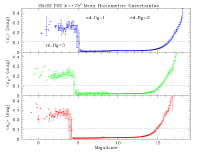 |
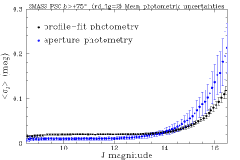 |
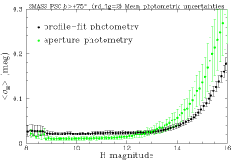 |
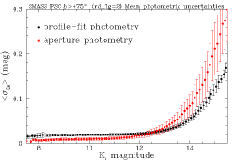 |
| Figure 7 | Figure 8 | Figure 9 | Figure 10 |
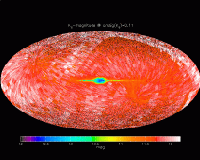 |
| Figure 11 |
